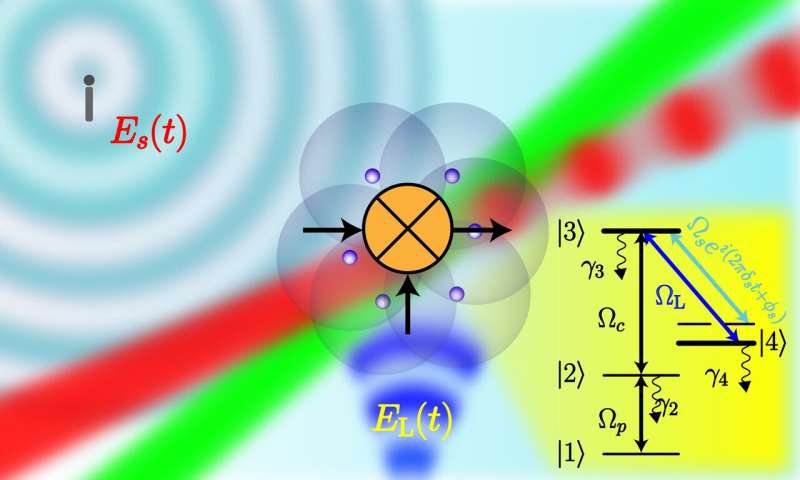Traceable microwave sensing reaches unprecedented sensitivities

Microwave sensors detect electromagnetic waves at frequencies starting from ~300 MHz up to the terahertz range. They allow us to survey remote terra incognita and detect faint radiations from distant galaxies in the universe. There has been a lot of progress in microwave sensing technology, but it is still challenging to achieve high sensitivity in SI-traceable measurements. We have now presented a new technique using Rydberg atoms, which gives access to a traceable microwave detection with unprecedented sensitivity. The work was published in Nature Physics.
Traditional microwave sensing exploits electronic-circuit architectures. When electromagnetic radiation is received by an antenna, it is transformed into a current or voltage signal which can be processed. However, the thermal noise intrinsic to electronic devices, which is usually generated by the random motion of electrons in the circuits, sets a fundamental limit on the smallest signal that can be measured by the device. And the measurements are hardly traceable.
Our team from the Laser Spectroscopy Institute at Shanxi University recently reported a related breakthrough in Nature Physics. By dressing Rydberg atoms with an engineered local microwave, we realized a new atomic superheterodyne receiver to provide exquisitely sensitive and traceable probes for measuring electromagnetic fields. The sensor reached a remarkably high sensitivity of 55 nV/(cm·Hz1/2), with a minimum detectable microwave signal 1000 lower than existing Rydberg sensors. Its measurement uncertainty achieves an impressive level of 10 nV/cm even in measuring sub-μV/cm fields that were previously inaccessible by atomic sensors. The atomic superhet also enables phase and high-precision frequency resolutions, making them especially useful tools in fields like Doppler sensing. This powerful new atomic sensor has great promise to become a next-generation electromagnetic-wave sensor, with quantum-noise-limited sensitivity and great accuracy, which may find important applications in diverse fields, including radio astronomy, radar technology and metrology.
"When we first demonstrated coherent optical detection of Rydberg states in 2006, we could not anticipate the amazing advances that lay ahead, particularly in the field of sensing. The Shanxi group, in particular, in their pioneering work on the Rydberg superhet technique, have shown remarkable innovation, leading to a sensor with unprecedented sensitivity," says Charles Adams, professor of physics at Durham University and winner of the 2014 Thomson medal from the Institute of Physics and the 2020 Holweck Prize awarded by French Physical Society, who was not involved in this research.
This story is part of Science X Dialog, where researchers can report findings from their published research articles. Visit this page for information about ScienceX Dialog and how to participate.
More information:
Jing et al. Atomic superheterodyne receiver based on microwave-dressed Rydberg spectroscopy, Nature Physics (2020). DOI: 10.1038/s41567-020-0918-5
Mingyong Jing is a PhD scholar at Laser Spectroscopy Institute, Shanxi University, China. His research interests include quantum sensing and Rydberg atomic physics.
Ying Hu is working as a professor at Laser Spectroscopy Institute, Shanxi University, China. Her research interests include quantum simulation, topological state of matter, nonequilibrium quantum many-body physics, and quantum sensing.